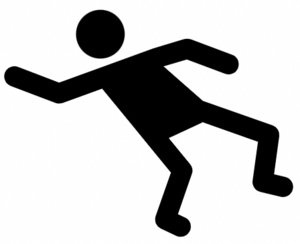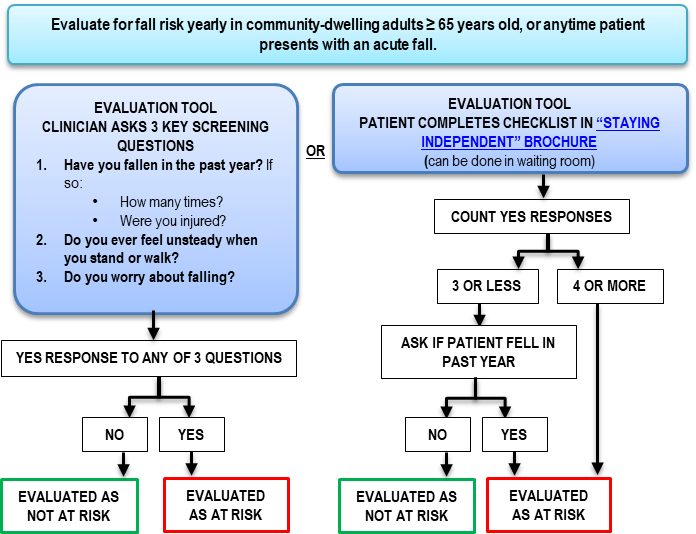The Of Dementia Fall Risk
The Of Dementia Fall Risk
Blog Article
Not known Incorrect Statements About Dementia Fall Risk
Table of ContentsWhat Does Dementia Fall Risk Do?The Of Dementia Fall RiskThe smart Trick of Dementia Fall Risk That Nobody is DiscussingDementia Fall Risk Can Be Fun For Everyone
A fall threat evaluation checks to see just how likely it is that you will drop. It is primarily done for older adults. The analysis usually includes: This consists of a collection of questions regarding your total health and if you've had previous drops or troubles with balance, standing, and/or walking. These devices examine your strength, balance, and stride (the way you walk).Interventions are referrals that might minimize your risk of falling. STEADI consists of three steps: you for your threat of falling for your threat aspects that can be enhanced to attempt to stop falls (for instance, equilibrium problems, damaged vision) to minimize your risk of dropping by utilizing effective approaches (for instance, providing education and learning and sources), you may be asked several inquiries including: Have you dropped in the past year? Are you fretted about dropping?
If it takes you 12 seconds or even more, it might imply you are at greater risk for an autumn. This examination checks strength and balance.
The placements will obtain more challenging as you go. Stand with your feet side-by-side. Relocate one foot halfway ahead, so the instep is touching the large toe of your other foot. Move one foot totally in front of the other, so the toes are touching the heel of your various other foot.
Things about Dementia Fall Risk
The majority of drops take place as an outcome of numerous adding variables; as a result, taking care of the threat of dropping starts with determining the aspects that add to drop threat - Dementia Fall Risk. A few of the most pertinent risk factors consist of: Background of prior fallsChronic medical conditionsAcute illnessImpaired gait and equilibrium, lower extremity weaknessCognitive impairmentChanges in visionCertain high-risk medicines and polypharmacyEnvironmental factors can also raise the threat for drops, including: Inadequate lightingUneven or harmed flooringWet or slippery floorsMissing or damaged hand rails and get hold of barsDamaged or incorrectly fitted tools, such as beds, wheelchairs, or walkersImproper use assistive devicesInadequate guidance of the people living in the NF, consisting of those who show hostile behaviorsA successful loss danger management program calls for a comprehensive clinical analysis, with input from all members of the interdisciplinary group

The treatment strategy must also consist of interventions that are system-based, such as those that advertise a safe setting (appropriate lights, handrails, order bars, etc). The performance of the interventions need to be assessed occasionally, and the care strategy changed as required to mirror changes in the autumn threat evaluation. Applying an autumn threat management system utilizing evidence-based finest practice can decrease the frequency of drops in the NF, while restricting the potential for fall-related injuries.
Fascination About Dementia Fall Risk
The AGS/BGS guideline recommends screening all adults aged 65 years and older for fall danger every year. This screening is composed of asking individuals whether they have dropped 2 or even more times in the past year or sought medical interest for a fall, or, if they have not dropped, whether they feel unstable when walking.
People that have actually dropped as soon as without injury needs to have their equilibrium and stride evaluated; those with stride or basics equilibrium problems need to obtain added analysis. A background of 1 fall without injury and without gait or balance troubles does not warrant more analysis past continued annual fall risk screening. Dementia Fall Risk. A fall risk analysis is called for as part of the Welcome to Medicare evaluation

Get This Report about Dementia Fall Risk
Documenting a falls history is just one of the quality indications for fall avoidance and administration. An important part of danger assessment is a medicine evaluation. A number of classes of medicines increase autumn danger (Table 2). Psychoactive medications in certain are independent predictors of drops. These drugs tend to be sedating, modify the sensorium, and harm balance and stride.
Postural hypotension can usually be minimized by minimizing this website the dose of blood pressurelowering medicines and/or stopping medicines that have orthostatic hypotension as an adverse effects. Use above-the-knee support pipe and sleeping with the head of the bed elevated might likewise reduce postural reductions in high blood pressure. The preferred elements of a fall-focused health examination are shown in Box 1.

A TUG time better than or equivalent to 12 seconds recommends high autumn threat. Being incapable to stand up from a chair of knee height without utilizing one's arms shows boosted autumn threat.
Report this page